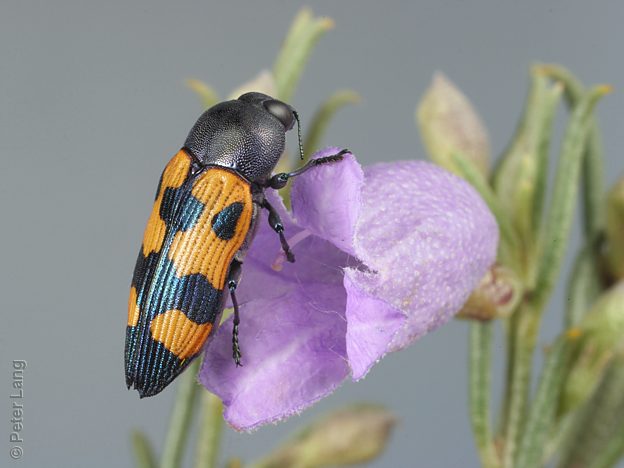
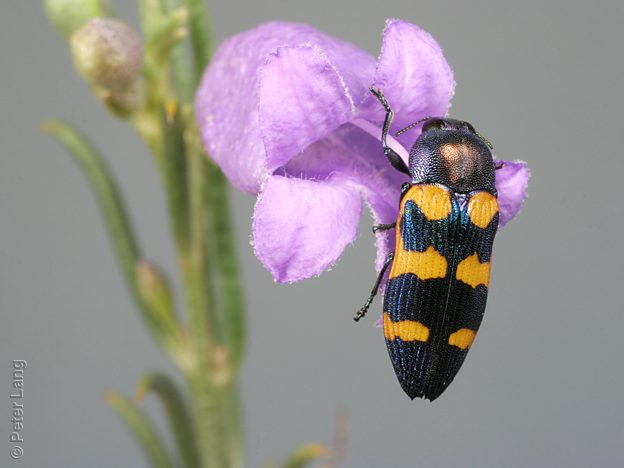
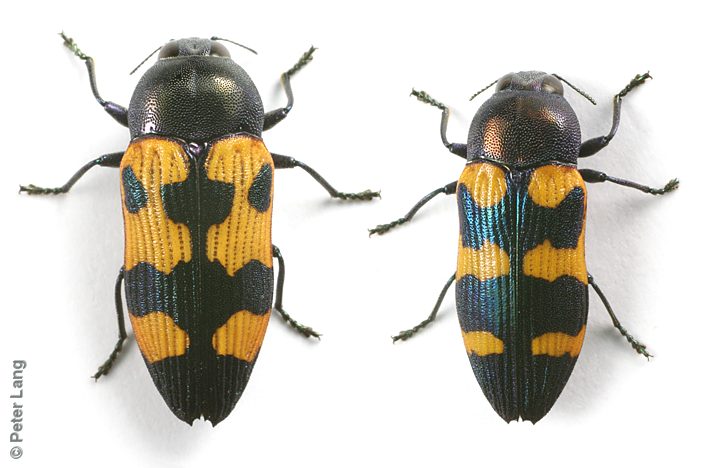
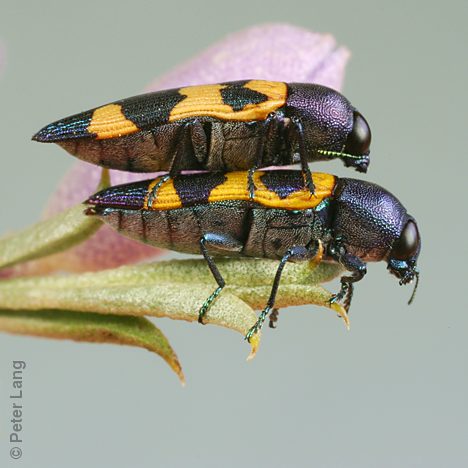
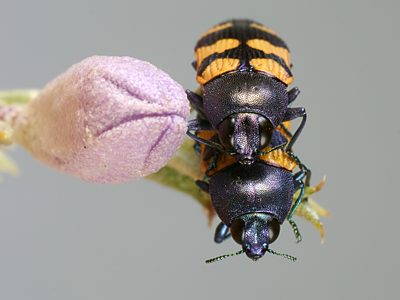
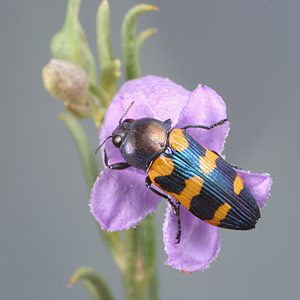
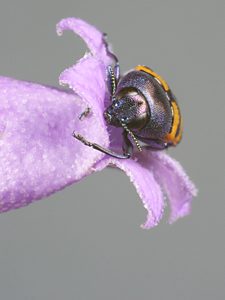
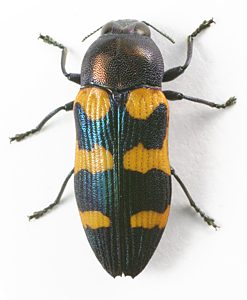
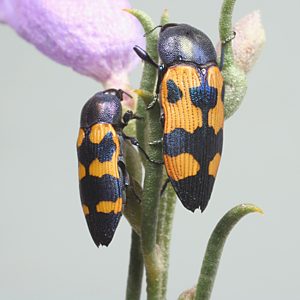
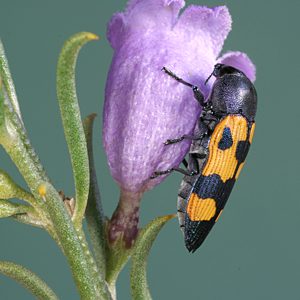
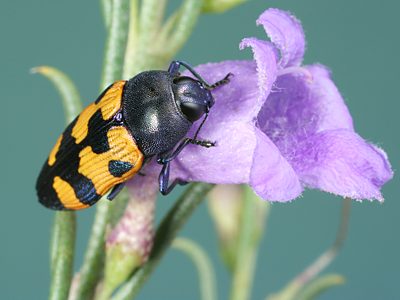
size¹:
×
3.6 mm











| male | female | |||||
|---|---|---|---|---|---|---|
| L1 | 8.9 | 7.6 – 9.65 | n = 5 | 10.0 | 9.2 – 11.3 | n = 9 |
| L2 | 9.1 | 8.7 – 9.5 | n = 2 | 9.8 | 9.1 – 10.5 | n = 7 |
| W | 3.3 | 2.85 – 3.6 | n = 5 | 3.8 | 3.35 – 4.3 | n = 9 |
| Legend | L1 | length from clypeus/frons to elytral apex (mean, range, sample size) |
| L2 | length from anterior of edge of eyes to elytral apex | |
| W | maximum width with elytra fully closed |
Apart from the distinctive features of the C. sexplagiata group (including reduction in tarsal pads and the triangular aedeagus) it has the elytra heavily marked on a yellow to orange background. Often slightly smaller, narrower, and relatively thicker (less flattened) than many of the related species in the C. sexplagiata group. Although not exclusive to this species, the scutellum is usually violet, matching the flower colour its principal adult host plant.
Particularly common on eastern Eyre Peninsula.
Problematic forms from the FR Region, including the southern Flinders Ranges area in the far northeast of EP Region, have the appearance of intergrades with other members of the C. sexplagiata group, namely C. piliventris or even C. nullaborica. They have been found on different hosts with cream to white flowers (Eucalyptus and Bursaria) and are treated here as a separate entity, C. sp. Flinders Ranges, q.v..
Castiarina vanderwoudeae is often found together with the similar looking Castiarina browningi, a member of the C. decemmaculata species group of Barker, 2006a. It appears that these separate groups, both of which are predominantly made up of species associated with cream to white flowered hosts, have each evolved a species attracted and adapted to the flowers of Eremophila scoparia (Broom Emubush). The two species have almost identical colouration dorsally, plus broadly similar morphology and size, coupled with their host specificity. They provide a good example of convergent, or at least parallel, evolution.
With the current (and likely past) overlap in ranges, Mullerian mimicry may be a driver of this convergence, at least in part. Mimicry, both Batesian and Mullerian, is well represented and developed in the genus Castiarina, with many large mimicry groups recognised (Barker, 2006a, p.25-33). Castiarina browningi most resembles its close relatives C. rediviva and C. cretata, but differs from SA collections assigned to those species in having narrower pale margins on the pronotum dorsally and overall a greater area of dark colouration on the ventral side, both features that enhance its resemblance to C. vanderwoudeae.
| Legend | P.J.Lang collection vouchered records | |
| other private collection or museum specimens, or sightings |
|
|
|
|
|
|
|
|
|
|
|
|
|
||||||||||||||||||||||||||||||||||||||||||||||||
|
|
|
|
|
|
|
|
|
|
|
|
|
||||||||||||||||||||||||||||||||||||||||||||||||
| Jul | Aug | Sep | Oct | Nov | Dec | Jan | Feb | Mar | Apr | May | Jun |
| Legend | live emerged adults, count > median value of 11 per quarter month | |
| live emerged adults, count <= median value of 11 | ||
| live non-emerged adults only, for that quarter month | ||
12 | number of active beetles for that quarter month |
| beetles | sites | SA regions¹ | family | position on host plant | |||||
| Eremophila scoparia | 89 | 15 | EP, MU | S | |||||
| Myoporum platycarpum | 5 | 3 | MU | S | |||||
| Leptospermum coriaceum | 1 | 1 | EP | M |
| Legend | beetles | count of beetles collected from, or sighted on, host plant taxon |
| sites | count of major sites (unique 10 km grid cells +/- some distinct approximate localities) | |
| Plant names in green are hyperlinked to a matching host species page with plant photos. | ||
| Code | beetles | % | host plant taxa | |
| S | Scrophulariaceae | 94 | 99% | 2 |
| M | Myrtaceae | 1 | 1% | 1 |
| position | beetles | sites | |
| on flower(s) | 50 | 14 | |
| on flowering plant | 18 | 7 | |
| on foliage or non-flowering plant | 1 | 1 | |
| on plant (unspecified) | 26 | 3 |
| colour | beetles | sites | SA regions¹ | |
| blue | 5 | 1 | EP |
Within its main area of occurrence on Eyre Peninsula, at least, adult beetles have been recorded exclusively from the violet to mauve coloured flowers of Broom Emubush Eremophila scoparia.
| ¹ Legend | regions | SA State Herbarium regions (map) EA: Eastern, EP: Eyre Peninsula, FR: Flinders Ranges, GT: Gairdner-Torrens, KI: Kangaroo Island, LE: Lake Eyre, MU: Murray, NL: Northern Lofty, NU: Nullarbor, NW: North-Western, SE: South-Eastern, SL: Southern Lofty, YP: Yorke Peninsula |
| size | The ellipse is the correct size when printed, indicative on a desktop screen, and likely to be wrong on a mobile device. |